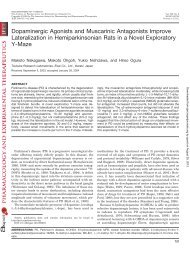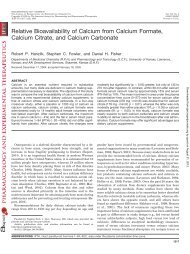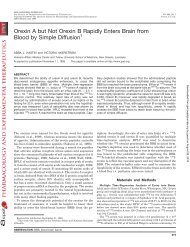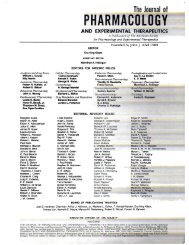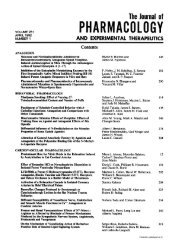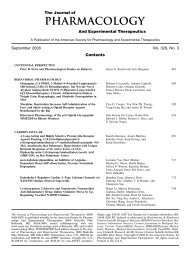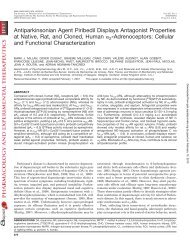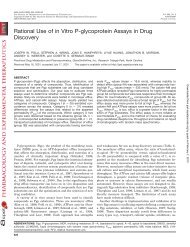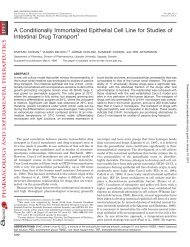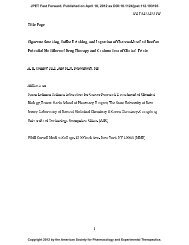Flavonoids from Artichoke (Cynara scolymus L.) - Journal of ...
Flavonoids from Artichoke (Cynara scolymus L.) - Journal of ...
Flavonoids from Artichoke (Cynara scolymus L.) - Journal of ...
Create successful ePaper yourself
Turn your PDF publications into a flip-book with our unique Google optimized e-Paper software.
0022-3565/04/3103-926–932$20.00<br />
THE JOURNAL OF PHARMACOLOGY AND EXPERIMENTAL THERAPEUTICS Vol. 310, No. 3<br />
Copyright © 2004 by The American Society for Pharmacology and Experimental Therapeutics 66639/1164130<br />
JPET 310:926–932, 2004 Printed in U.S.A.<br />
<strong>Flavonoids</strong> <strong>from</strong> <strong>Artichoke</strong> (<strong>Cynara</strong> <strong>scolymus</strong> L.) Up-Regulate<br />
Endothelial-Type Nitric-Oxide Synthase Gene Expression in<br />
Human Endothelial Cells<br />
Huige Li, Ning Xia, Isolde Brausch, Ying Yao, and Ulrich Förstermann<br />
Department <strong>of</strong> Pharmacology, Johannes Gutenberg University, Mainz, Germany (H.L., I.B., Y.Y., U.F.); and the Department <strong>of</strong><br />
Cardiology, University <strong>of</strong> Heidelberg, Heidelberg, Germany (N.X.)<br />
Received February 6, 2004; accepted May 3, 2004<br />
ABSTRACT<br />
Nitric oxide (NO) produced by endothelial nitric-oxide synthase<br />
(eNOS) represents an antithrombotic and anti-atherosclerotic<br />
principle in the vasculature. Hence, an enhanced expression <strong>of</strong><br />
eNOS in response to pharmacological interventions could provide<br />
protection against cardiovascular diseases. In EA.hy 926<br />
cells, a cell line derived <strong>from</strong> human umbilical vein endothelial<br />
cells (HUVECs), an artichoke leaf extract (ALE) increased the<br />
activity <strong>of</strong> the human eNOS promoter (determined by luciferase<br />
reporter gene assay). An organic subfraction <strong>from</strong> ALE was<br />
more potent in this respect than the crude extract, whereas an<br />
aqueous subfraction <strong>of</strong> ALE was without effect. ALE and the<br />
organic subfraction there<strong>of</strong> also increased eNOS mRNA expression<br />
(measured by an RNase protection assay) and eNOS<br />
protein expression (determined by Western blot) both in EA.hy<br />
926 cells and in native HUVECs. NO production (measured by<br />
Nitric oxide (NO) produced by endothelial-type nitric-oxide<br />
synthase (eNOS) plays a protective physiological role in the<br />
vasculature (Li and Förstermann, 2000a). NO is a potent<br />
vasodilator and contributes to blood pressure control. Blockade<br />
<strong>of</strong> NO synthesis with pharmacological NOS inhibitors<br />
causes significant peripheral vasoconstriction and elevation<br />
<strong>of</strong> blood pressure (Rees et al., 1989). Similarly, mice with a<br />
disrupted eNOS gene are hypertensive and lack endothelium-dependent,<br />
NO-mediated vasodilation (Huang et al.,<br />
1995).<br />
Besides its vasodilator effects, NO also protects blood vessels<br />
<strong>from</strong> thrombosis by inhibiting platelet aggregation and<br />
This work was supported by the Collaborative Research Center SFB 553<br />
(project A1 to H.L. and U.F.) <strong>from</strong> the Deutsche Forschungsgemeinschaft,<br />
Bonn, Germany, and by Lichtwer Pharma AG, Berlin, Germany.<br />
Article, publication date, and citation information can be found at<br />
http://jpet.aspetjournals.org.<br />
doi:10.1124/jpet.104.066639.<br />
NO-ozone chemiluminescence) was increased by both extracts.<br />
In organ chamber experiments, ex vivo incubation (18 h)<br />
<strong>of</strong> rat aortic rings with the organic subfraction <strong>of</strong> ALE enhanced<br />
the NO-mediated vasodilator response to acetylcholine, indicating<br />
that the up-regulated eNOS remained functional. Caffeoylquinic<br />
acids and flavonoids are two major groups <strong>of</strong> constituents<br />
<strong>of</strong> ALE. Interestingly, the flavonoids luteolin and<br />
cynaroside increased eNOS promoter activity and eNOS mRNA<br />
expression, whereas the caffeoylquinic acids cynarin and chlorogenic<br />
acid were without effect. Thus, in addition to the lipidlowering<br />
and antioxidant properties <strong>of</strong> artichoke, an increase in<br />
eNOS gene transcription may also contribute to its beneficial<br />
cardiovascular pr<strong>of</strong>ile. <strong>Artichoke</strong> flavonoids are likely to represent<br />
the active ingredients mediating eNOS up-regulation.<br />
adhesion. In addition, endothelial NO possesses multiple anti-atherosclerotic<br />
properties, which include 1) prevention <strong>of</strong><br />
leukocyte adhesion to vascular endothelium and leukocyte<br />
migration into the vascular wall; 2) decreased endothelial<br />
permeability, reduced influx <strong>of</strong> lipoproteins into the vascular<br />
wall and inhibition <strong>of</strong> low-density lipoprotein (LDL) oxidation;<br />
and 3) inhibition <strong>of</strong> DNA synthesis, mitogenesis, and<br />
proliferation <strong>of</strong> vascular smooth muscle cells (Li and Förstermann,<br />
2000a). In agreement with these protective effects <strong>of</strong><br />
endothelial NO, pharmacological inhibition <strong>of</strong> eNOS caused<br />
accelerated atherosclerosis in rabbits (Cayatte et al., 1994).<br />
Based on these antihypertensive and anti-atherosclerotic effects,<br />
the enhancement <strong>of</strong> endothelial NO production could be<br />
<strong>of</strong> prophylactic or therapeutic interest.<br />
<strong>Artichoke</strong> (<strong>Cynara</strong> <strong>scolymus</strong> L.) is one <strong>of</strong> the world’s oldest<br />
medicinal plants. It has been known by the ancient Egyptians,<br />
and the ancient Greeks and Romans used it as a<br />
digestive aid. Clinical trials have shown antidyspeptic (Fin-<br />
ABBREVIATIONS: NO, nitric oxide; ALE, artichoke leaf extract; apoE-KO, apolipoprotein E-knockout; ASF, aqueous subfraction <strong>from</strong> ALE; DRB,<br />
5,6-dichloro-1--D-rib<strong>of</strong>uranosylbenzimidazole; HUVEC, human umbilical vein endothelial cell; kb, kilobase(s); LDL, low-density lipoprotein;<br />
L-NAME, N G -nitro-L-arginine methyl ester; NOS, nitric-oxide synthase; eNOS, endothelial-type NOS; OSF, organic subfraction <strong>from</strong> ALE; RT-PCR,<br />
reverse transcription-polymerase chain reaction; SNAP, S-nitroso-N-penicillamine.<br />
926<br />
Downloaded <strong>from</strong><br />
jpet.aspetjournals.org by guest on April 2, 2013
telmann, 1996; Marakis et al., 2002; Holtmann et al., 2003)<br />
and lipid-lowering effects (Fintelmann, 1996; Englisch et al.,<br />
2000) <strong>of</strong> artichoke leaf extract (ALE). Oral administration <strong>of</strong><br />
ALE increased bile flow in rats (Saenz-Rodriguez et al.,<br />
2002). Such a choleretic action has also been documented in<br />
humans (Kirchh<strong>of</strong>f et al., 1994). In primarily cultured rat<br />
hepatocytes (Gebhardt, 1998) as well as in HepG2 cells<br />
(Gebhardt, 2002), artichoke extracts inhibited cholesterol<br />
biosynthesis, likely due to an indirect inhibition <strong>of</strong> 3-hydroxy-<br />
3-methylglutaryl-CoA reductase activity (Gebhardt, 1998).<br />
Interestingly, ALE also possesses antioxidant properties. It<br />
protected cultured rat hepatocytes against hydroperoxideinduced<br />
oxidative stress (Gebhardt, 1997). ALE also inhibited<br />
LDL oxidation (Brown and Rice-Evans, 1998) and reduced<br />
the production <strong>of</strong> intracellular reactive oxygen species<br />
by oxidized LDL in cultured endothelial cells and monocytes<br />
(Zapolska-Downar et al., 2002).<br />
Besides its lipid-lowering and antioxidant activities<br />
(Brown and Rice-Evans, 1998; Gebhardt, 1998; Zapolska-<br />
Downar et al., 2002), preliminary evidence <strong>from</strong> our laboratory<br />
suggested that artichoke may also stimulate vascular<br />
NO production. Therefore, the current study was designed to<br />
investigate the effect <strong>of</strong> artichoke on the vascular NO system<br />
and to identify the active constituents.<br />
Materials and Methods<br />
Materials. Extracts <strong>from</strong> artichoke leaves were provided by Lichtwer<br />
Pharma AG (Berlin, Germany). Three types <strong>of</strong> extracts were<br />
used (Table 1). ALE was the dried supernatant <strong>of</strong> an aqueous extraction<br />
<strong>of</strong> artichoke leaves (commercially produced as LI220, Suprasern).<br />
An aqueous solution <strong>of</strong> ALE was further extracted with a<br />
mixture <strong>of</strong> ethyl acetate and n-butanol (2:1, v/v) resulting in an<br />
organic and an aqueous phase. The two phases were separated and<br />
the solvents were evaporated. This yielded two extracts, the organic<br />
subfraction (OSF) and the aqueous subfraction (ASF), respectively<br />
(Table 1).<br />
Cynarin (1,3-dicaffeoylquinic acid) and cynaroside (luteolin-7-Oglucopyranoside)<br />
were obtained <strong>from</strong> AppliChem (Darmstadt, Germany);<br />
chlorogenic acid (5-O-caffeoylquinic acid) was obtained <strong>from</strong><br />
Cayman Chemical (Ann Arbor, MI). Luteolin was obtained <strong>from</strong><br />
Sigma (Taufkirchen, Germany). S-Nitroso-N-penicillamine (SNAP)<br />
and 5,6-dichloro-1--D-rib<strong>of</strong>uranosylbenzimidazole (DRB) were obtained<br />
<strong>from</strong> Merck (Darmstadt, Germany).<br />
Cell Culture. Human umbilical vein endothelial cells (HUVECs)<br />
were isolated by collagenase digestion. HUVECs were cultured in<br />
endothelial cell growth medium (PromoCell, Heidelberg, Germany).<br />
HUVECs <strong>from</strong> passages 3 to 5 were used in the experiments.<br />
HUVEC-derived EA.hy 926 endothelial cells were kindly provided by<br />
Dr. Cora-Jean Edgell (Chapel Hill, NC). EA.hy 926 endothelial cells<br />
were grown under 10% CO 2 in Dulbecco’s modified Eagle’s medium<br />
(Sigma) supplemented with 10% fetal bovine serum, 2 mM L-glutamine,<br />
1 mM sodium pyruvate, 100 U/ml penicillin, 100 g/ml<br />
streptomycin, and 1 hypoxanthine, amethopterin/methotrexate,<br />
and thymin (Invitrogen, Karlsruhe, Germany) (Li and Förstermann,<br />
2000b).<br />
TABLE 1<br />
<strong>Artichoke</strong> extracts used<br />
eNOS Up-Regulation by <strong>Artichoke</strong> <strong>Flavonoids</strong> 927<br />
Analysis <strong>of</strong> eNOS Promoter Activity by Stable Transfection<br />
<strong>of</strong> EA.hy 926 Cells. A stable EA.hy 926 cell line was generated by<br />
transfection <strong>of</strong> EA.hy 926 cells with pGL 3-eNOS-Hu-3500-neo, which<br />
contains a neomycin-resistance gene and a 3.5-kb promoter fragment<br />
<strong>of</strong> human eNOS driving the luciferase reporter gene (Li et al., 1998).<br />
Stable EA.hy 926 cells were cultured in medium containing 1 mg/ml<br />
compound G418. For analysis <strong>of</strong> eNOS promoter activity, the stably<br />
transfected cells were incubated with artichoke extracts for 18 h.<br />
Then, cell lysates were prepared and luciferase activities were determined<br />
as described (Li et al., 1998). The luciferase activity, normalized<br />
for protein concentration <strong>of</strong> cell lysates, was used as a<br />
determinant <strong>of</strong> eNOS promoter activity.<br />
RNase Protection Assay for eNOS mRNA Analyses. Confluent<br />
HUVECs and EA.hy 926 cells were incubated with artichoke<br />
extracts for 18 h and total RNA was isolated. The expression <strong>of</strong> eNOS<br />
mRNA was analyzed by the RNase protection assay as described<br />
previously (Li et al., 1998; Li and Förstermann, 2000b).<br />
Real-Time RT-PCR for eNOS mRNA Analyses. In some experiments,<br />
eNOS mRNA expression was analyzed with quantitative<br />
real-time RT-PCR using an iCycler iQ System (Bio-Rad, Munich,<br />
Germany). Confluent HUVECs and EA.hy 926 cells were incubated<br />
with cynarin, chlorogenic acid, luteolin, or cynaroside for 6hand<br />
total RNA was isolated. Total RNA (0.5 g) was used for real-time<br />
RT-PCR analysis with the QuantiTect Probe RT-PCR kit (QIAGEN,<br />
Hilden, Germany). Sequences <strong>of</strong> used primers were GTGGCTGTCT-<br />
GCATGGACCT (forward) and CCACGATGGTGACTTTGGCT (reverse).<br />
The sequence <strong>of</strong> the dual-labeled TaqMan probe was AGTG-<br />
GAAATCAACGTGGCCGTGCTGC.<br />
Western Blot for eNOS Protein Analyses. Confluent EA.hy<br />
926 cells were incubated with artichoke extracts for 18 h and total<br />
protein was isolated. Western blotting was performed using 50 g <strong>of</strong><br />
protein and a monoclonal anti-eNOS antibody (BD Biosciences<br />
PharMingen, San Diego, CA), as described previously (Li and Förstermann,<br />
2000b). Immunocomplexes were developed using an enhanced<br />
horseradish peroxidase/luminol chemiluminescence reagent<br />
(PerkinElmer Life and Analytical Sciences, Boston, MA) according to<br />
the manufacturer’s instructions.<br />
Determination <strong>of</strong> NO Synthesis. EA.hy 926 cells were treated<br />
with artichoke extracts for 18 h and then stimulated with 10 M<br />
calcium ionophore A23187 for 1 h. The supernatants were collected<br />
and the oxidation products <strong>of</strong> NO, nitrite and nitrate, were assayed<br />
as a measure <strong>of</strong> NO synthesis. After reduction <strong>of</strong> nitrate with nitrate<br />
reductase, total nitrite was determined by NO-ozone chemiluminescence<br />
using a NOA 280 NO Analyzer (Sievers, Boulder, CO). Total<br />
protein content <strong>of</strong> the cells was determined (Bradford, 1976), and<br />
nitrite levels were normalized for protein (Li et al., 2002a, 2003).<br />
Organ Chamber Experiment using Rat Aorta. Aortas were<br />
isolated <strong>from</strong> male Sprague-Dawley rats (250–300 g) and cut into<br />
rings <strong>of</strong> 3 mm width. The rings were washed twice with penicillin/<br />
streptomycin (100 U/ml, 100 g/ml)-containing PBS and then maintained<br />
in cell culture incubators in Dulbecco’s modified Eagle’s medium<br />
(supplemented with 10% fetal bovine serum, 2 mM<br />
L-glutamine, 1 mM sodium pyruvate, 100 U/ml penicillin, and 100<br />
g/ml streptomycin) for 18 h, with or without cynara OSF (100<br />
g/ml), or, in other experiments, for 8 h with or without 30 M<br />
cynaroside. After the ex vivo incubation, rings were mounted into<br />
organ chambers and isometric tension was measured. Concentration-response<br />
curves to norepinephrine (1 nM to 1 M) were gener-<br />
Extract Description <strong>of</strong> Extraction Drug/Extract Ratio Caffeoylquinic Acid Content Flavonoid Content<br />
% (w/w)<br />
ALE Aqueous extract <strong>of</strong> artichoke leaves 4–6:1 10.10 2.17<br />
OSF Organic subfraction <strong>of</strong> ALE 20–30:1 26.30 13.29<br />
ASF Aqueous subfraction <strong>of</strong> ALE 5–7.5:1 6.30 0.76<br />
Downloaded <strong>from</strong><br />
jpet.aspetjournals.org by guest on April 2, 2013
928 Li et al.<br />
ated (a contraction induced by 80 mM KCl was set at 100%). After<br />
washout, the rings were contracted again using 100 nM norepinephrine,<br />
and relaxation concentration-response curves were generated<br />
with acetylcholine in the absence or presence <strong>of</strong> the NOS inhibitor<br />
N G -nitro-L-arginine methyl ester (L-NAME, 1 mM). Vasodilator response<br />
to the NO donor SNAP was achieved after precontraction<br />
with 100 nM norepinephrine in the presence <strong>of</strong> L-NAME.<br />
Statistics. Statistical differences between mean values were determined<br />
by analysis <strong>of</strong> variance followed by Fisher’s protected least<br />
significant difference test for comparison <strong>of</strong> different means.<br />
Results<br />
eNOS Promoter Activity in Human EA.hy 926 Endothelial<br />
cells. An 18-h ALE treatment <strong>of</strong> EA.hy 926 cells<br />
stably transfected with a 3.5-kb human eNOS promoter fragment<br />
resulted in a concentration-dependent increase in<br />
eNOS promoter activity (Fig. 1). The maximal increase was<br />
seen with 100 g/ml ALE. The cynara OSF was more potent<br />
than ALE. The ASF, however, was without any effect.<br />
eNOS mRNA Expression in Human Endothelial<br />
Cells. Treatment <strong>of</strong> HUVECs and EA.hy 926 cells for 18 h<br />
with 100 g/ml ALE or OSF resulted in a significant increase<br />
in eNOS mRNA expression, as analyzed with the RNase<br />
protection assay (Fig. 2).<br />
eNOS Protein Expression in EA.hy 926 Cells. As analyzed<br />
with Western blot, both ALE and OSF increased eNOS<br />
protein in EA.hy 926 cells after an 18-h treatment (Fig. 3).<br />
Densitometric analyses <strong>of</strong> the three blots demonstrated an<br />
average increase to 185% <strong>of</strong> control after 100 g/ml ALE and<br />
to 197% <strong>of</strong> control after 100 g/ml OSF.<br />
Fig. 1. Effects <strong>of</strong> artichoke extracts on human eNOS promoter activity.<br />
Human EA.hy 926 endothelial cells were stably transfected with a 3.5-kb<br />
human eNOS promoter fragment driving a luciferase reporter gene. ALE<br />
is the crude aqueous extract <strong>from</strong> artichoke leaves; OSF and ASF are the<br />
organic and aqueous subfractions <strong>of</strong> ALE, respectively. The EA.hy 926<br />
cells were treated with artichoke extracts for 18 h, and then luciferase<br />
activity was analyzed as a determinant <strong>of</strong> eNOS promoter activity. Symbols<br />
represent mean S.E.M. <strong>of</strong> three experiments (, P 0.01; , P <br />
0.001 versus untreated cells).<br />
Fig. 2. <strong>Artichoke</strong> extracts increase eNOS mRNA expression in human endothelial<br />
cells. HUVECs and EA.hy 926 cells were treated for 18 h with ALE<br />
(100 g/ml) or the OSF (100 g/ml) there<strong>of</strong>. Then, eNOS mRNA expression<br />
was analyzed with RNase protection assays. Panel A displays an original gel<br />
<strong>of</strong> an RNase protection assay (performed in triplicate). The gel shows the<br />
protected bands for eNOS (top) and for -actin (bottom; used for normalization).<br />
Panels B and C illustrate the results <strong>of</strong> densitometric analyses <strong>of</strong> three<br />
different gels; columns represent mean S.E.M. <strong>of</strong> the three experiments<br />
(, P 0.01; , P 0.001 compared with control).<br />
Fig. 3. <strong>Artichoke</strong> extracts enhance eNOS protein expression. EA.hy 926<br />
cells were treated for 18 h with ALE (100 g/ml) or the OSF (100 g/ml)<br />
there<strong>of</strong>, and eNOS protein expression was analyzed with Western blot<br />
using a monoclonal anti-eNOS antibody. The blot shown is representative<br />
<strong>of</strong> three independent experiments with similar results.<br />
Downloaded <strong>from</strong><br />
jpet.aspetjournals.org by guest on April 2, 2013
NO Production in EA.hy 926 Cells. Both ALE and OSF<br />
increased NO synthesis in EA.hy 926 cells after an 18-h<br />
treatment, as determined by the NO-ozone chemiluminescence<br />
assay (Fig. 4). OSF was more efficacious than ALE in<br />
stimulating endothelial NO production.<br />
In contrast to the long-term effects on eNOS expression<br />
(and thus activity), ALE and OSF had no acute effect on<br />
eNOS activity. Incubation <strong>of</strong> EA.hy 926 cells for up to 30 min<br />
with ALE or OSF (up to 100 g/ml), or with the flavonoid<br />
cynaroside (up to 30 M), did not increase NO production.<br />
Effects <strong>of</strong> <strong>Artichoke</strong> <strong>Flavonoids</strong> and Caffeoylquinic<br />
Acids. ALE is known to contain large amounts <strong>of</strong> polyphenolic<br />
compounds, with caffeoylquinic acids and flavonoids<br />
being major constituents. We therefore tested four commercially<br />
available compounds known to be present in ALE: two<br />
caffeoylquinic acids (cynarin and chlorogenic acid) and two<br />
flavonoids (luteolin and cynaroside). As shown in Fig. 5,<br />
luteolin and cynaroside, but not cynarin or chlorogenic acid,<br />
increased eNOS promoter activity in a concentration-dependent<br />
manner. In parallel, the two artichoke flavonoids also<br />
increased eNOS mRNA expression both in HUVECs and<br />
EA.hy 926 cells (Fig. 6). Cynarin and chlorogenic acid did not<br />
increase eNOS mRNA expression (three experiments).<br />
eNOS mRNA Stability. To study eNOS mRNA stability,<br />
EA.hy 926 cells were treated either with 100 g/ml OSF for<br />
18 h or with 30 M cynaroside for 8 h. After the pretreatment,<br />
transcription was stopped by adding 60 M DRB, an<br />
inhibitor <strong>of</strong> RNA polymerase II transcription (Cai et al.,<br />
2001), to the culture medium. eNOS mRNA levels were determined<br />
with quantitative real-time RT-PCR at 0, 6, 12, and<br />
24 h thereafter. As shown in Fig. 7, OSF and cynaroside had<br />
no significant effect on eNOS mRNA stability.<br />
Vasomotor Responses <strong>of</strong> Rat Aorta ex Vivo. To investigate<br />
functional consequences <strong>of</strong> an eNOS up-regulation, we<br />
Fig. 4. <strong>Artichoke</strong> extracts augment endothelial NO production. EA.hy<br />
926 cells were treated with artichoke extracts for 18 h and then stimulated<br />
with 10 M calcium ionophore A23187 for 1 h. The supernatant was<br />
collected and the oxidation products <strong>of</strong> NO, nitrite and nitrate, were<br />
assayed by NO-ozone chemiluminescence using a NO Analyzer. Symbols<br />
represent mean S.E.M. <strong>of</strong> three experiments (, P 0.05; , P <br />
0.01).<br />
eNOS Up-Regulation by <strong>Artichoke</strong> <strong>Flavonoids</strong> 929<br />
Fig. 5. Effects <strong>of</strong> artichoke polyphenolic compounds on human eNOS<br />
promoter activity. Human EA.hy 926 endothelial cells were stably transfected<br />
with a 3.5-kb human eNOS promoter fragment driving a luciferase<br />
reporter gene. Cells were treated with caffeoylquinic acids (cynarin and<br />
chlorogenic acid) or flavonoids (luteolin and cynaroside), and then luciferase<br />
activity was analyzed as a determinant <strong>of</strong> eNOS promoter activity.<br />
Symbols represent mean S.E.M. <strong>of</strong> three experiments (, P 0.05; ,<br />
P 0.001 versus untreated cells).<br />
studied the effects <strong>of</strong> OSF and cynaroside on vasomotion. In<br />
organ chamber experiments, rat aortic rings pretreated with<br />
OSF for 18 h showed a decreased vasoconstriction in response<br />
to norepinephrine (Fig. 8A). The NOS inhibitor L-<br />
NAME (1 mM) did not change basal vascular tone. However,<br />
the norepinephrine-induced vasoconstriction was significantly<br />
enhanced by L-NAME, both in control and OSF-pretreated<br />
rings, although the OSF-exposed rings did not reach<br />
the same level <strong>of</strong> contraction as control vessels (Fig. 8A).<br />
The vasodilator response to acetylcholine was significantly<br />
enhanced by OSF pretreatment (Fig. 8B). No significant relaxation<br />
was observed in the presence <strong>of</strong> the NOS inhibitor<br />
L-NAME (Fig. 8B). The vasodilator response to the NO donor<br />
SNAP was not changed by OSF (Fig. 8C).<br />
Pretreatment <strong>of</strong> aortic rings with the flavonoid cynaroside<br />
had an effect on vasomotion similar to that <strong>of</strong> OSF. Cynaroside-pretreated<br />
rings showed decreased constriction response<br />
to norepinephrine (similar to Fig. 8A, three experiments).<br />
Also, the vasodilator response to acetylcholine was enhanced<br />
(similar to Fig. 8B, three experiments).<br />
Additional experiments using aortic rings without OSF/<br />
cynaroside pretreatment showed that OSF and cynaroside<br />
has no acute effects on vasomotion. In the absence <strong>of</strong> acetylcholine,<br />
no relaxation to OSF (10–300 g/ml) or cynaroside<br />
(1–100 M) was observed within 10 min in rings precontracted<br />
with 100 nM norepinephrine (three experiments).<br />
Discussion<br />
In the present study, we investigated the effects <strong>of</strong> artichoke<br />
on the synthesis <strong>of</strong> endothelial NO. Long-term incubation<br />
with a crude extract <strong>from</strong> artichoke leaves or its organic<br />
subfraction increased eNOS promoter activity, eNOS mRNA<br />
expression, eNOS protein expression, and NO production in<br />
Downloaded <strong>from</strong><br />
jpet.aspetjournals.org by guest on April 2, 2013
930 Li et al.<br />
Fig. 6. <strong>Artichoke</strong> flavonoids increase eNOS mRNA expression in human<br />
endothelial cells. HUVECs (panel A) and EA.hy 926 cells (panel B) were<br />
treated with artichoke flavonoids (luteolin and cynaroside), and eNOS<br />
mRNA expression was analyzed with real-time RT-PCR. Columns represent<br />
mean S.E.M. <strong>of</strong> three experiments (, P 0.05; , P 0.01<br />
compared with control).<br />
cultured human vascular endothelial cells. Furthermore,<br />
long-term ex vivo incubation <strong>of</strong> aortic rings with the organic<br />
subfraction enhanced the endothelium-dependent, NO-mediated<br />
vasodilator response to acetylcholine.<br />
NO synthesis can be modulated by eNOS activity and/or<br />
eNOS gene expression (Li et al., 2002b,c). Since short-term<br />
incubation with the artichoke extract had no effect on NO<br />
production in EA.hy 926 cells and did not change vascular<br />
tone <strong>of</strong> aortic rings, the effects <strong>of</strong> artichoke on endothelial NO<br />
synthesis seem to result mainly or exclusively <strong>from</strong> up-regulation<br />
<strong>of</strong> eNOS gene expression. Due to the antithrombotic,<br />
anti-atherosclerotic, and antihypertensive properties <strong>of</strong> endothelial<br />
NO, the eNOS enzyme could be an interesting target<br />
for the prevention or therapy <strong>of</strong> cardiovascular diseases.<br />
In vivo up-regulation <strong>of</strong> eNOS gene expression seems to be a<br />
reasonable and realistic strategy.<br />
There is precedent for this strategy in the form <strong>of</strong><br />
the 3-hydroxy-3-methylglutaryl-CoA reductase inhibitors<br />
(statins). Statins possess vasoprotective properties independent<br />
<strong>of</strong> their cholesterol-lowering effect, which include the<br />
up-regulation <strong>of</strong> eNOS expression in platelets and endothelial<br />
cells. This eNOS up-regulation was found to be associated<br />
with a decrease in platelet activation (Laufs et al., 2000b), an<br />
Fig. 7. <strong>Artichoke</strong> extract and flavonoid had no effect on eNOS mRNA<br />
stability. Human EA.hy 926 endothelial cells were pretreated with vehicle<br />
(Co), OSF (100 g/ml), or cynaroside (30 M), and then gene transcription<br />
was terminated by DRB (60 M). eNOS mRNA was analyzed<br />
with real-time RT-PCR at indicated time points after adding DRB. eNOS<br />
levels at time 0h<strong>of</strong>allthree groups were set at 100%. Symbols represent<br />
mean S.E.M. <strong>of</strong> three experiments.<br />
improvement <strong>of</strong> endothelial function in hypercholesterolemia<br />
(Wilson et al., 2001), an augmentation <strong>of</strong> cerebral blood flow<br />
(Endres et al., 1998; Laufs et al., 2000a), and a protection<br />
<strong>from</strong> stroke (Endres et al., 1998; Laufs et al., 2000a; Amin-<br />
Hanjani et al., 2001). Up-regulation <strong>of</strong> eNOS gene expression<br />
seems to be the predominant, if not the only, mechanism,<br />
because the protective effects are absent in eNOS-deficient<br />
mice.<br />
However, one recent study has questioned the beneficial<br />
effects <strong>of</strong> eNOS up-regulation in vivo (Ozaki et al., 2002). In<br />
this study, a transgenic mouse strain (eNOS-Tg) was interbred<br />
with atherogenic apoE-deficient (apoE-KO) mice resulting<br />
in apoE-KO/eNOS-Tg mice. These mice expressed about<br />
11-fold more eNOS than did the wild-type mice and, unexpectedly,<br />
developed larger atherosclerotic lesions than did<br />
apoE-KO mice (Ozaki et al., 2002). As discussed by the authors<br />
themselves (Ozaki et al., 2000), “uncoupling” <strong>of</strong> eNOS<br />
seems to occur under these circumstances. It is established<br />
that under certain pathological conditions, eNOS can generate<br />
superoxide rather than NO by dissociation <strong>of</strong> the ferrousdioxygen<br />
complex (Vasquez-Vivar et al., 1998; Xia et al.,<br />
1998). Superoxide produced by the uncoupled eNOS may<br />
enhance the preexisting oxidative stress. The molecular<br />
mechanisms underlying eNOS uncoupling have not been<br />
completely understood. A relative lack <strong>of</strong> (6R)-5,6,7,8-tetrahydro-L-biopterin,<br />
an eNOS c<strong>of</strong>actor, seems to play a crucial<br />
role in many cases (Stuehr et al., 2001; Vasquez-Vivar et al.,<br />
2003).<br />
In contrast to the extreme overexpression <strong>of</strong> eNOS mentioned<br />
above, the eNOS up-regulation by pharmacological<br />
compounds like statins is usually moderate (3-fold). At<br />
these levels, the up-regulated eNOS seems to remain functional.<br />
In addition, a novel compound <strong>from</strong> Aventis (Strasbourg,<br />
France) (Cpd2431), which also moderately up-regulates<br />
eNOS expression, has been shown to reduce<br />
experimental atherosclerosis in apoE-KO mice (Wohlfart et<br />
Downloaded <strong>from</strong><br />
jpet.aspetjournals.org by guest on April 2, 2013
Fig. 8. Effects <strong>of</strong> artichoke extract on vasomotion <strong>of</strong> rat aorta. Isolated rat<br />
aortic rings were incubated ex vivo with control (Co) or OSF (100 g/ml)<br />
for 18 h and then mounted into organ chambers. Constriction response<br />
was achieved with norepinephrine (NE; panel A). Vasodilator response to<br />
acetylcholine (ACh) or to the NO donor SNAP was carried out after<br />
precontraction with 100 nM norepinephrine, in the absence or presence <strong>of</strong><br />
the NOS inhibitor L-NAME (1 mM) (panels B and C). Symbols represent<br />
mean S.E.M. <strong>of</strong> three to four experiments (, P 0.05, versus Co; #, P <br />
0.05, versus without L-NAME).<br />
al., 2002). In the present study, artichoke extracts increased<br />
eNOS gene expression to a similar extent. Results <strong>from</strong> the<br />
organ bath experiments indicate that the up-regulated eNOS<br />
remained functional.<br />
The active constituents responsible for this eNOS-up-regulating<br />
action <strong>of</strong> artichoke are present in the OSF. The OSF<br />
is rich in polyphenolic compounds, with caffeoylquinic acids<br />
and flavonoids as the major chemical components. Examples<br />
are cynarin and chlorogenic acid for caffeic acid derivatives,<br />
and luteolin as well as apigenin for flavonoids (Rechner et al.,<br />
2001; Llorach et al., 2002; Wang et al., 2003). The aqueous<br />
subfraction contains sesquiterpenes (cynaropicrin, aguerin<br />
B, and grosheimin) and sesquiterpene glycosides (cynarascolosides<br />
A, B, and C) (Shimoda et al., 2003). Polyphenolic<br />
compounds, such as resveratrol (present in red wine and<br />
grapes), can increase eNOS gene expression, as recently reported<br />
by our group (Wallerath et al., 2002, 2003).<br />
The artichoke extract OSF enriched in flavonoids and caffeoylquinic<br />
acids was more efficacious in stimulating eNOS<br />
expression than was the crude extract. The ASF, in contrast,<br />
contains only small amounts <strong>of</strong> these compounds and was<br />
without effect on eNOS expression (Table 1). Results <strong>from</strong><br />
our experiments with cynarin, chlorogenic acid, luteolin, and<br />
eNOS Up-Regulation by <strong>Artichoke</strong> <strong>Flavonoids</strong> 931<br />
cynaroside suggest that artichoke flavonoids represent one<br />
group <strong>of</strong> the compounds that are responsible for the eNOS<br />
up-regulation caused by cynara extracts.<br />
In conclusion, the present study demonstrates that artichoke<br />
leaf extracts increase eNOS gene expression and NO<br />
production in cultured human vascular endothelial cells. <strong>Artichoke</strong><br />
leaf extract also enhances endothelium-dependent<br />
vasodilation in rat aorta. This novel action <strong>of</strong> the plant seems<br />
to be mediated, at least in part, by artichoke flavonoids.<br />
Based on the beneficial effects <strong>of</strong> endothelial NO, vasoprotective<br />
and anti-atherosclerotic effects are likely to ensue also in<br />
vivo.<br />
Acknowledgments<br />
We thank Dr. Timo Windeck (Lichtwer Pharma AG, Berlin, Germany)<br />
and Dr. Petra M. Schwarz (Department <strong>of</strong> Pharmacology,<br />
Mainz, Germany) for carefully reading the manuscript.<br />
References<br />
Amin-Hanjani S, Stagliano NE, Yamada M, Huang PL, Liao JK, and Moskowitz MA<br />
(2001) Mevastatin, an HMG-CoA reductase inhibitor, reduces stroke damage and<br />
upregulates endothelial nitric oxide synthase in mice. Stroke 32:980–986.<br />
Bradford MM (1976) A rapid and sensitive method for the quantitation <strong>of</strong> microgram<br />
quantities <strong>of</strong> protein utilizing the principle <strong>of</strong> protein-dye binding. Anal Biochem<br />
72:248–254.<br />
Brown JE and Rice-Evans CA (1998) Luteolin-rich artichoke extract protects low<br />
density lipoprotein <strong>from</strong> oxidation in vitro. Free Radic Res 29:247–255.<br />
Cai H, Davis ME, Drummond GR, and Harrison DG (2001) Induction <strong>of</strong> endothelial<br />
NO synthase by hydrogen peroxide via a Ca(2)/calmodulin-dependent protein<br />
kinase II/janus kinase 2-dependent pathway. Arterioscler Thromb Vasc Biol 21:<br />
1571–1576.<br />
Cayatte AJ, Palacino JJ, Horten K, and Cohen RA (1994) Chronic inhibition <strong>of</strong> nitric<br />
oxide production accelerates neointima formation and impairs endothelial function<br />
in hypercholesterolemic rabbits. Arterioscler Thromb 14:753–759.<br />
Endres M, Laufs U, Huang Z, Nakamura T, Huang P, Moskowitz MA, and Liao JK<br />
(1998) Stroke protection by 3-hydroxy-3-methylglutaryl (HMG)-CoA reductase<br />
inhibitors mediated by endothelial nitric oxide synthase. Proc Natl Acad Sci USA<br />
95:8880–8885.<br />
Englisch W, Beckers C, Unkauf M, Ruepp M, and Zinserling V (2000) Efficacy <strong>of</strong><br />
artichoke dry extract in patients with hyperlipoproteinemia. Arzneim-Forsch 50:<br />
260–265.<br />
Fintelmann V (1996) Antidyspeptic and lipid-lowering effect <strong>of</strong> artichoke leaf extract.<br />
Z Allg Med 72 (Suppl 2):3–19.<br />
Gebhardt R (1997) Antioxidative and protective properties <strong>of</strong> extracts <strong>from</strong> leaves <strong>of</strong><br />
the artichoke (<strong>Cynara</strong> <strong>scolymus</strong> L.) against hydroperoxide-induced oxidative<br />
stress in cultured rat hepatocytes. Toxicol Appl Pharmacol 144:279–286.<br />
Gebhardt R (1998) Inhibition <strong>of</strong> cholesterol biosynthesis in primary cultured rat<br />
hepatocytes by artichoke (<strong>Cynara</strong> <strong>scolymus</strong> L.) extracts. J Pharmacol Exp Ther<br />
286:1122–1128.<br />
Gebhardt R (2002) Prevention <strong>of</strong> taurolithocholate-induced hepatic bile canalicular<br />
distortions by HPLC-characterized extracts <strong>of</strong> artichoke (<strong>Cynara</strong> <strong>scolymus</strong>) leaves.<br />
Planta Med 68:776–779.<br />
Holtmann G, Adam B, Haag S, Collet W, Grunewald E, and Windeck T (2003)<br />
Efficacy <strong>of</strong> artichoke leaf extract in the treatment <strong>of</strong> patients with functional<br />
dyspepsia: a six-week placebo-controlled, double-blind, multicentre trial. Aliment<br />
Pharmacol Ther 18:1099–1105.<br />
Huang PL, Huang Z, Mashimo H, Bloch KD, Moskowitz MA, Bevan JA, and Fishman<br />
MC (1995) Hypertension in mice lacking the gene for endothelial nitric oxide<br />
synthase. Nature (Lond) 377:239–242.<br />
Kirchh<strong>of</strong>f R, Beckers CH, Kirchh<strong>of</strong>f GM, Trinczek-Gärtner H, and Petrowitz OH Jr<br />
(1994) Increase in choleresis by means <strong>of</strong> artichoke extract: results <strong>of</strong> a randomised<br />
placebo-controlled double-blind study. Phytomedicine 1:107–115.<br />
Laufs U, Endres M, Stagliano N, Amin Hanjani S, Chui DS, Yang SX, Simoncini T,<br />
Yamada M, Rabkin E, Allen PG, et al. (2000a) Neuroprotection mediated by<br />
changes in the endothelial actin cytoskeleton. J Clin Investig 106:15–24.<br />
Laufs U, Gertz K, Huang P, Nickenig G, Bohm M, Dirnagl U, and Endres M (2000b)<br />
Atorvastatin upregulates type III nitric oxide synthase in thrombocytes, decreases<br />
platelet activation and protects <strong>from</strong> cerebral ischemia in normocholesterolemic<br />
mice. Stroke 31:2442–2449.<br />
Li H, Burkhardt C, Heinrich U-R, Brausch I, Xia N, and Förstermann U (2003)<br />
Histamine upregulates gene expression <strong>of</strong> the endothelial NO synthase in human<br />
vascular endothelial cells. Circulation 107:2348–2354.<br />
Li H and Förstermann U (2000a) Nitric oxide in the pathogenesis <strong>of</strong> vascular disease.<br />
J Pathol 190:244–254.<br />
Li H and Förstermann U (2000b) Structure-activity relationship <strong>of</strong> staurosporine<br />
analogs in regulating expression <strong>of</strong> endothelial nitric-oxide synthase gene. Mol<br />
Pharmacol 57:427–435.<br />
Li H, Junk P, Huwiler A, Burkhardt C, Wallerath T, Pfeilschifter J, and Förstermann<br />
U (2002a) Dual effect <strong>of</strong> ceramide on human endothelial cells: induction <strong>of</strong><br />
oxidative stress and transcriptional upregulation <strong>of</strong> endothelial nitric oxide synthase.<br />
Circulation 106:2250–2256.<br />
Li H, Oehrlein SA, Wallerath T, Ihrig-Biedert I, Wohlfart P, Ulshöfer T, Jessen T,<br />
Downloaded <strong>from</strong><br />
jpet.aspetjournals.org by guest on April 2, 2013
932 Li et al.<br />
Herget T, Förstermann U, and Kleinert H (1998) Activation <strong>of</strong> protein kinase C<br />
alpha and/or epsilon enhances transcription <strong>of</strong> the human endothelial nitric oxide<br />
synthase gene. Mol Pharmacol 53:630–637.<br />
Li H, Wallerath T, and Förstermann U (2002b) Physiological mechanisms regulating<br />
the expression <strong>of</strong> endothelial-type NO synthase. Nitric Oxide 7:132–147.<br />
Li H, Wallerath T, Münzel T, and Förstermann U (2002c) Regulation <strong>of</strong> endothelialtype<br />
NO synthase expression in pathophysiology and in response to drugs. Nitric<br />
Oxide 7:149–164.<br />
Llorach R, Espin JC, Tomas-Barberan FA, and Ferreres F (2002) <strong>Artichoke</strong> (<strong>Cynara</strong><br />
<strong>scolymus</strong> L.) byproducts as a potential source <strong>of</strong> health-promoting antioxidant<br />
phenolics. J Agric Food Chem 50:3458–3464.<br />
Marakis G, Walker AF, Middleton RW, Booth JC, Wright J, and Pike DJ (2002)<br />
<strong>Artichoke</strong> leaf extract reduces mild dyspepsia in an open study. Phytomedicine<br />
9:694–699.<br />
Ozaki M, Kawashima S, Yamashita T, Hirase T, Namiki M, Inoue N, Hirata K, Yasui<br />
H, Sakurai H, Yoshida Y, et al. (2002) Overexpression <strong>of</strong> endothelial nitric oxide<br />
synthase accelerates atherosclerotic lesion formation in apoE-deficient mice.<br />
J Clin Investig 110:331–340.<br />
Rechner AR, Pannala AS, and Rice-Evans CA (2001) Caffeic acid derivatives in<br />
artichoke extract are metabolised to phenolic acids in vivo. Free Radic Res 35:195–<br />
202.<br />
Rees DD, Palmer RM, and Moncada S (1989) Role <strong>of</strong> endothelium-derived nitric<br />
oxide in the regulation <strong>of</strong> blood pressure. Proc Natl Acad Sci USA 86:3375–3378.<br />
Saenz-Rodriguez T, Garcia-Gimenez D, and de la Puerta Vazquez R (2002)<br />
Choleretic activity and biliary elimination <strong>of</strong> lipids and bile acids induced by an<br />
artichoke leaf extract in rats. Phytomedicine 9:687–693.<br />
Shimoda H, Ninomiya K, Nishida N, Yoshino T, Morikawa T, Matsuda H, and<br />
Yoshikawa M (2003) Anti-hyperlipidemic sesquiterpenes and new sesquiterpene<br />
glycosides <strong>from</strong> the leaves <strong>of</strong> artichoke (<strong>Cynara</strong> <strong>scolymus</strong> L.): structure requirement<br />
and mode <strong>of</strong> action. Bioorg Med Chem Lett 13:223–228.<br />
Stuehr D, Pou S, and Rosen GM (2001) Oxygen reduction by nitric-oxide synthases.<br />
J Biol Chem 276:14533–14536.<br />
Vasquez-Vivar J, Kalyanaraman B, and Martasek P (2003) The role <strong>of</strong> tetrahydrobiopterin<br />
in superoxide generation <strong>from</strong> eNOS: enzymology and physiological<br />
implications. Free Radic Res 37:121–127.<br />
Vasquez-Vivar J, Kalyanaraman B, Martasek P, Hogg N, Masters BS, Karoui H,<br />
Tordo P, and Pritchard KA Jr (1998) Superoxide generation by endothelial nitric<br />
oxide synthase: the influence <strong>of</strong> c<strong>of</strong>actors. Proc Natl Acad Sci USA 95:9220–9225.<br />
Wallerath T, Deckert G, Ternes T, Anderson H, Li H, Witte K, and Förstermann U<br />
(2002) Resveratrol, a polyphenolic phytoalexin present in red wine, enhances<br />
expression and activity <strong>of</strong> endothelial nitric oxide synthase. Circulation 106:1652–<br />
1658.<br />
Wallerath T, Poleo D, Li H, and Förstermann U (2003) Red wine increases the<br />
expression <strong>of</strong> human endothelial nitric oxide synthase: a mechanism that may<br />
contribute to its beneficial cardiovascular effects. J Am Coll Cardiol 41:471–478.<br />
Wang M, Simon JE, Aviles IF, He K, Zheng QY, and Tadmor Y (2003) Analysis <strong>of</strong><br />
antioxidative phenolic compounds in artichoke (<strong>Cynara</strong> <strong>scolymus</strong> L.). J Agric Food<br />
Chem 51:601–608.<br />
Wilson SH, Simari RD, Best PJ, Peterson TE, Lerman LO, Aviram M, Nath KA,<br />
Holmes DR, and Lerman A (2001) Simvastatin preserves coronary endothelial<br />
function in hypercholesterolemia in the absence <strong>of</strong> lipid lowering. Arterioscler<br />
Thromb Vasc Biol 21:122–128.<br />
Wohlfart P, Tiemann M, Strobel H, Suzuki T, Dharanipragada R, Li H, Förstermann<br />
U, and Rütten H (2002) A novel endothelial nitric oxide synthase expression<br />
enhancer reduces atherocsclerosis in apoE-deficient mice (Abstract). Circulation<br />
(Suppl) 106:II-213.<br />
Xia Y, Tsai AL, Berka V, and Zweier JL (1998) Superoxide generation <strong>from</strong> endothelial<br />
nitric-oxide synthase. A Ca2/calmodulin-dependent and tetrahydrobiopterin<br />
regulatory process. J Biol Chem 273:25804–25808.<br />
Zapolska-Downar D, Zapolski-Downar A, Naruszewicz M, Siennicka A, Krasnodebska<br />
B, and Koldziej B (2002) Protective properties <strong>of</strong> artichoke (<strong>Cynara</strong> <strong>scolymus</strong>)<br />
against oxidative stress induced in cultured endothelial cells and monocytes. Life<br />
Sci 71:2897–2908.<br />
Address correspondence to: Dr. Huige Li, Department <strong>of</strong> Pharmacology,<br />
Johannes Gutenberg University, Obere Zahlbacher Strasse 67, D-55131<br />
Mainz, Germany. E-mail: HuigeLi@mail.Uni-Mainz.de<br />
Downloaded <strong>from</strong><br />
jpet.aspetjournals.org by guest on April 2, 2013



